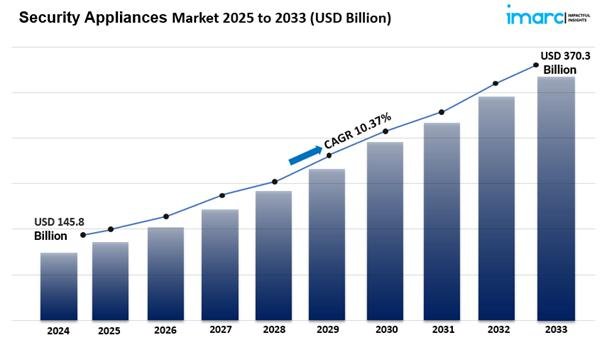IMARC Group has recently released a new research study titled “Security Appliances Market Report by Type (Firewall, Unified Threat Management (UTM), Intrusion Detection and Prevention (IDP), Content Management, Virtual Private Network (VPN), and Others), Deployment (Cloud-based, On-premises), End User (Small and Medium Enterprises, Large Organizations), Vertical (BFSI, Healthcare, IT and Telecom, Retail, Energy and Utilities, Manufacturing, and Others), and Region 2025-2033”, offers a detailed analysis of the market drivers, segmentation, growth opportunities, trends and competitive landscape to understand the current and future market scenarios.
Report Highlights:
How Big Is the Security Appliances Market?
The global security appliances market size reached USD 145.8 Billion in 2024. Looking forward, IMARC Group expects the market to reach USD 370.3 Billion by 2033, exhibiting a growth rate (CAGR) of 10.37% during 2025-2033.
Request to Get the Sample Report: https://www.imarcgroup.com/security-appliances-market/requestsample
Market Dynamics of the Security Appliances Market
Key Market Trends in 2025
• AI-Driven Security Appliances and Advanced Threat Intelligence: By 2025, the integration of Artificial Intelligence (AI) and Machine Learning (ML) is a defining trend in security appliances. These technologies are crucial for enabling real-time threat detection, predictive analytics, and automated response capabilities. AI-powered firewalls, Intrusion Detection/Prevention Systems (IDPS), and Unified Threat Management (UTM) solutions are becoming standard, allowing for more precise identification of zero-day threats, polymorphic malware, and sophisticated social engineering attacks like deepfakes and voice cloning, which are on the rise. This enhances the speed and efficiency of cybersecurity defenses against rapidly evolving attack vectors.
• Convergence with Cloud-Native Security (SASE & SSE): As businesses continue their migration to cloud environments, the market is witnessing a strong convergence of traditional security appliances with cloud-based security solutions. By 2025, the adoption of Secure Access Service Edge (SASE) and Security Service Edge (SSE) architectures is becoming more widespread. This trend leads to the increased deployment of cloud-based firewalls (Firewall-as-a-Service, FWaaS) and other cloud-native security services that offer superior scalability, flexibility, and cost-efficiency compared to on-premise hardware alone. Security appliance manufacturers are innovating to ensure seamless integration and unified management across hybrid (on-premises and cloud) environments.
• Focus on Zero-Trust Architectures: The principle of “never trust, always verify” is becoming foundational. By 2025, security appliances are increasingly designed to support Zero Trust frameworks, implementing granular access controls, continuous verification of users and devices, and micro-segmentation capabilities. This ensures that even internal threats or compromised credentials are met with strict security protocols, minimizing the attack surface and containing breaches.
• Increased Demand for Unified Threat Management (UTM) and Extended Detection and Response (XDR): Organizations, particularly Small and Medium-sized Businesses (SMBs), are moving towards consolidated security platforms. UTM solutions, which combine firewalls, VPNs, antivirus, intrusion prevention, and web filtering into a single appliance, are gaining popularity for their cost-efficiency and simplified management. Furthermore, the integration of Extended Detection and Response (XDR) within security appliances is a growing trend, offering more holistic visibility and automated response across endpoints, networks, and cloud environments.
Market Dynamics Driving Growth
• Escalating Cybersecurity Threats and Sophistication: The primary driver remains the continuous increase in the frequency and sophistication of cyber threats. In 2025, organizations face advanced ransomware attacks (including double extortion), more frequent nation-state sponsored attacks targeting critical infrastructure, highly sophisticated phishing campaigns leveraging AI, and persistent supply chain attacks. This escalating threat landscape, with global cybercrime damages projected to reach unprecedented levels, compels businesses to invest heavily in advanced security appliances for robust protection of sensitive data and critical operations.
• Proliferation of Cloud Computing, IoT, and Remote Work: The widespread adoption of cloud computing, the explosion of IoT devices, and the normalization of remote/hybrid work models are significantly expanding the attack surface for organizations. This distributed environment necessitates adaptable and scalable security solutions that traditional perimeter-based appliances alone cannot provide. Security appliances are evolving to secure endpoints beyond the traditional network perimeter, manage access for a dispersed workforce, and protect data across multi-cloud and hybrid infrastructures. Approximately 70% of enterprises are planning to upgrade their network security infrastructure due to these shifts.
• Stringent Regulatory Compliance and Data Privacy Mandates: Regulatory pressures continue to be a powerful catalyst for the security appliances market. Regulations such as GDPR, HIPAA, CCPA, and upcoming regional data privacy laws impose strict requirements for data protection, access control, audit logging, and incident reporting. Organizations are proactively investing in security appliances that facilitate compliance, mitigate the risk of costly penalties, and safeguard their reputation from data breaches. The fragmentation of global regulations also pushes for solutions that offer comprehensive, adaptable compliance capabilities.
• Addressing the Cybersecurity Skills Gap: The global shortage of skilled cybersecurity professionals is prompting organizations to seek security solutions that offer greater automation, simplified management, and integrated functionalities. This drives demand for appliances that can reduce the manual burden on security teams, enabling them to handle more complex tasks efficiently. AI-driven features and integrated platforms within security appliances help bridge this skills gap by automating threat detection and response.
Get Discount On The Purchase Of This Report: https://www.imarcgroup.com/checkout?id=2400&method=1670
Security Appliances Market Report Segmentation:
Breakup By Type:
• Firewall
• Unified Threat Management (UTM)
• Intrusion Detection and Prevention (IDP)
• Content Management
• Virtual Private Network (VPN)
• Others
Based on the type, the market has been divided into firewall, unified threat management (UTM), intrusion detection and prevention (IDP), content management, virtual private network (VPN), and others.
Breakup By Deployment:
• Cloud-based
• On-premises
Based on deployment, the market has been classified into cloud-based and on-premises.
Breakup By End User:
• Small and Medium Enterprises
• Large Organizations
Based on the end user, the market has been bifurcated into small and medium enterprises and large organizations.
Breakup By Vertical:
• BFSI
• Healthcare
• IT and Telecom
• Retail
• Energy and Utilities
• Manufacturing
• Others
Based on vertical, the market has been divided into BFSI, healthcare, IT and telecom, retail, energy and utilities, manufacturing, and others.
Breakup By Region:
• North America
• Asia Pacific
• Europe
• Latin America
• Middle East and Africa
Region-wise the market has been segmented into North America (United States and Canada); Asia Pacific (China, Japan, India, South Korea, Australia, Indonesia, and others); Europe (Germany, France, United Kingdom, Italy, Spain, Russia, and others); Latin America (Brazil, Mexico, and others); and Middle East and Africa.
Top Security Appliances Market Leaders:
The security appliances market research report outlines a detailed analysis of the competitive landscape, offering in-depth profiles of major companies.
Some of the key players in the market are:
• Bosch Sicherheitssysteme GmbH (Robert Bosch GmbH)
• Check Point Software Technologies
• Cisco Systems Inc.
• Fortinet Inc.
• Hewlett Packard Enterprise Company
• Honeywell International Inc.
• Intel Corporation
• Juniper Networks Inc.
• NortonLifeLock Inc.
• Palo Alto Networks Inc.
• Trend Micro Inc.
Ask Analyst for Customized Report: https://www.imarcgroup.com/request?type=report&id=2400&flag=C
Key Highlights of the Report:
• Market Performance (2019-2024)
• Market Outlook (2025-2033)
• Market Trends
• Market Drivers and Success Factors
• Impact of COVID-19
• Value Chain Analysis
If you need specific information that is not currently within the scope of the report, we will provide it to you as a part of the customization.
About Us
IMARC Group is a leading market research company that offers management strategy and market research worldwide. We partner with clients in all sectors and regions to identify their highest-value opportunities, address their most critical challenges, and transform their businesses.
IMARC’s information products include major market, scientific, economic and technological developments for business leaders in pharmaceutical, industrial, and high technology organizations. Market forecasts and industry analysis for biotechnology, advanced materials, pharmaceuticals, food and beverage, travel and tourism, nanotechnology and novel processing methods are at the top of the company’s expertise.
Contact Us:
IMARC Group
134 N 4th St
Brooklyn, NY 11249, USA
Email: sales@imarcgroup.com
Americas: +1-631-791-1145 | Europe & Africa: +44-753-713-2163 | Asia: +91-120-433-0800
This release was published on openPR.


















